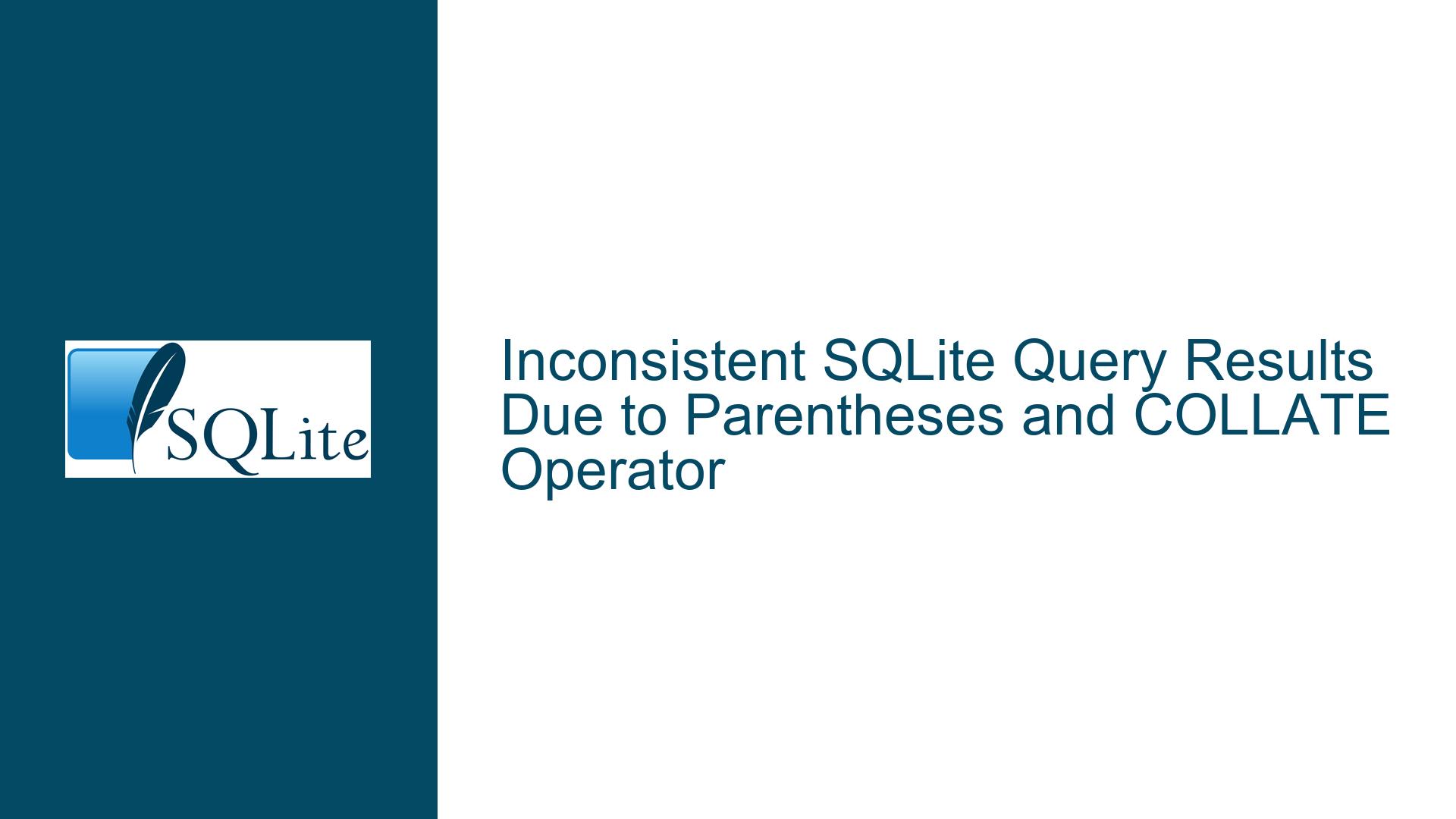Inconsistent SQLite Query Results Due to Parentheses and COLLATE Operator
Issue Overview: Parentheses and COLLATE Operator Impact Query Results
The core issue revolves around the inconsistent behavior of SQLite queries when parentheses and the COLLATE operator are used in the JOIN clause. Specifically, the presence or absence of parentheses around certain expressions in the ON clause of a JOIN operation leads to different query results, even though the queries appear to be logically equivalent. This inconsistency is particularly evident when the COLLATE operator is applied to different parts of the expression due to the placement of parentheses.
The problem manifests in the following way:
- In the first query, the COLLATE operator is applied to the entire AND expression due to the presence of additional parentheses. This results in a non-empty result set.
- In the second query, the COLLATE operator is applied only to the right-hand side of the AND expression (i.e.,
t0.c0), leading to an empty result set.
This behavior is unexpected because, logically, the two queries should produce the same result. The inconsistency arises from how SQLite’s query optimizer and execution engine interpret the placement of parentheses and the scope of the COLLATE operator. The issue is further complicated by the fact that the behavior changes when a WHERE clause is added to the query, which should not affect the results of the JOIN operation itself.
Possible Causes: Misinterpretation of Parentheses and COLLATE Operator Scope
The root cause of this issue lies in how SQLite’s query parser and optimizer handle the combination of parentheses and the COLLATE operator in the ON clause of a JOIN operation. The following factors contribute to the problem:
Parentheses and Operator Precedence: In SQL, parentheses are used to explicitly define the order of evaluation of expressions. However, in this case, the additional parentheses in the ON clause alter the scope of the COLLATE operator. When the COLLATE operator is applied to the entire AND expression, it affects how the comparison is performed, leading to different results compared to when the COLLATE operator is applied only to one side of the AND expression.
COLLATE Operator Behavior: The COLLATE operator in SQLite is used to specify a collation sequence for string comparison. When applied to an expression, it changes how the expression is evaluated. In this case, the COLLATE operator is applied to either the entire AND expression or just one side of it, depending on the placement of parentheses. This difference in scope leads to different evaluation results.
Query Optimizer Interpretation: SQLite’s query optimizer may interpret the presence of parentheses differently, especially when combined with operators like COLLATE. The optimizer might generate different execution plans based on the placement of parentheses, which can lead to inconsistent results. This is particularly true when the optimizer decides to reorder or simplify expressions during query planning.
Version-Specific Behavior: The issue appears to be a regression in SQLite version 3.39.0, as it does not occur in earlier versions like 3.31.1. This suggests that changes in the query optimizer or parser in newer versions of SQLite introduced this inconsistency. The regression was later fixed in a subsequent check-in, indicating that the behavior was unintended.
Interaction with WHERE Clause: The presence of a WHERE clause further complicates the issue. In some cases, the WHERE clause can influence the results of the JOIN operation, even though it should only filter the final result set. This interaction suggests that the query optimizer might be reordering or combining operations in a way that affects the outcome.
Troubleshooting Steps, Solutions & Fixes: Resolving Inconsistent Query Results
To address the issue of inconsistent query results due to parentheses and the COLLATE operator, the following steps can be taken:
Update SQLite Version: The first and most straightforward solution is to update SQLite to the latest version. The issue has been identified as a regression and was fixed in a subsequent check-in (c7e3a13a3288c577). By updating to a version that includes this fix, the inconsistent behavior should no longer occur.
Review Query Syntax: When writing complex queries involving JOINs and the COLLATE operator, it is essential to carefully review the placement of parentheses. Ensure that the parentheses are used to explicitly define the intended order of evaluation and that the COLLATE operator is applied to the correct part of the expression. For example, if the intention is to apply the COLLATE operator to the entire AND expression, ensure that the parentheses are placed accordingly:
SELECT v0.c0 FROM t1 INNER JOIN v0 ON (((v0.c0) AND (t0.c0)) COLLATE RTRIM) LEFT OUTER JOIN t0 ON (('a') ISNULL);Conversely, if the COLLATE operator should only apply to one side of the AND expression, ensure that the parentheses reflect this:
SELECT v0.c0 FROM t1 INNER JOIN v0 ON ((v0.c0) AND (t0.c0 COLLATE RTRIM)) LEFT OUTER JOIN t0 ON (('a') ISNULL);Avoid Unnecessary Parentheses: In some cases, excessive use of parentheses can lead to confusion and unintended behavior. Simplify the query by removing unnecessary parentheses while ensuring that the intended logic is preserved. For example:
SELECT v0.c0 FROM t1 INNER JOIN v0 ON v0.c0 AND t0.c0 COLLATE RTRIM LEFT OUTER JOIN t0 ON 'a' ISNULL;This simplification reduces the likelihood of misinterpretation by the query optimizer.
Test Queries Across Different Versions: If you are working with multiple versions of SQLite, it is crucial to test your queries across these versions to identify any version-specific behavior. This is especially important if you are upgrading from an older version to a newer one, as regressions or changes in the query optimizer might affect query results.
Use Explicit Collation Sequences: Instead of relying on the COLLATE operator within the query, consider defining explicit collation sequences for the columns involved in the JOIN operation. This can be done at the schema level when creating the tables:
CREATE TABLE t0 (c0 COLLATE RTRIM); CREATE TABLE t1 (c0); CREATE VIEW v0(c0) AS SELECT 0.4 FROM t0;By defining the collation sequence at the schema level, you can avoid the need to use the COLLATE operator in the query, reducing the potential for misinterpretation.
Analyze Query Execution Plans: Use SQLite’s
EXPLAINorEXPLAIN QUERY PLANcommands to analyze how the query optimizer is interpreting and executing your queries. This can provide insights into whether the optimizer is reordering or combining operations in a way that affects the results. For example:EXPLAIN QUERY PLAN SELECT v0.c0 FROM t1 INNER JOIN v0 ON v0.c0 AND t0.c0 COLLATE RTRIM LEFT OUTER JOIN t0 ON 'a' ISNULL;Reviewing the execution plan can help identify any unexpected behavior and guide adjustments to the query.
Report Bugs and Contribute to Fixes: If you encounter similar issues in SQLite, consider reporting them to the SQLite development team. Providing detailed bug reports, including minimal reproducible examples and version information, can help the team identify and fix issues more quickly. Additionally, contributing to the SQLite project by testing and verifying fixes can help improve the stability and reliability of the database.
Consider Alternative Database Systems: While SQLite is a powerful and lightweight database, it may not always be the best choice for every use case. If you encounter persistent issues with query behavior or performance, consider evaluating alternative database systems that might better suit your needs. However, this should be a last resort after exhausting all other troubleshooting and optimization options within SQLite.
By following these steps, you can effectively troubleshoot and resolve issues related to inconsistent query results caused by parentheses and the COLLATE operator in SQLite. Ensuring that your queries are clear, concise, and well-tested across different versions of SQLite will help maintain the reliability and performance of your database applications.






